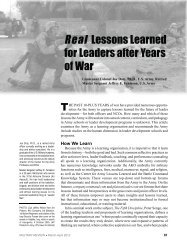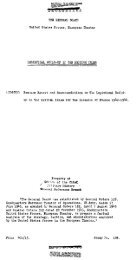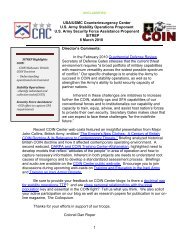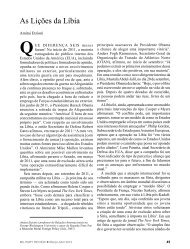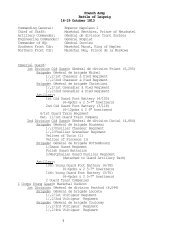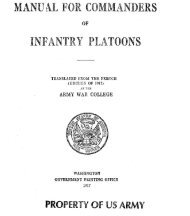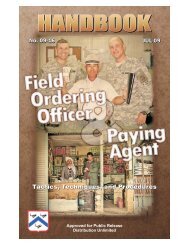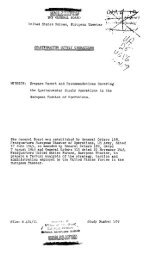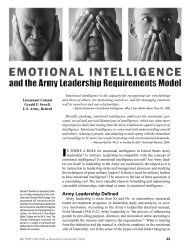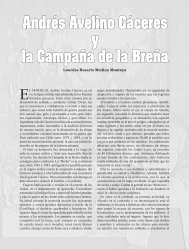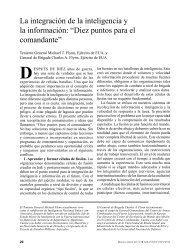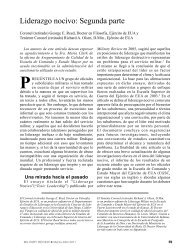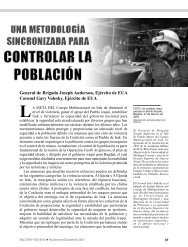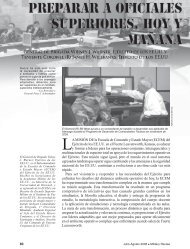Armor Magazine Counterinsurgency Selected Works - US Army
Armor Magazine Counterinsurgency Selected Works - US Army
Armor Magazine Counterinsurgency Selected Works - US Army
Create successful ePaper yourself
Turn your PDF publications into a flip-book with our unique Google optimized e-Paper software.
“The ordinary civilian caught in the middle between government and insurgent forces should<br />
be the main objective of insurgent or counterinsurgent operations. Civilians are the center of<br />
gravity and the aspect of this particular struggle that can tip the favor from one side to another,<br />
thus enabling insurgents to recruit local citizens to join the insurgency, and encouraging the<br />
local populace to support the insurgency by providing a base of operations or hospitality to the<br />
insurgent, as well as financial and other means of support.”<br />
sional to understand the intricate details that drive a countryman<br />
to turn away from his government for ideological purposes.<br />
Social reasons could involve anything from religion to race,<br />
which create deep divisions among all parties involved in the<br />
conflict and become sectarian in nature. If it were an internal<br />
conflict involving a government force against a sectarian group,<br />
then we would possibly find insurgents and government forces<br />
crossing lines to support the sectarian group with whom they<br />
have a religious or ethnic alliance. This was very common during<br />
the Balkan wars in the 1990s, after the former communist<br />
state of Yugoslavia divided into six independent states.<br />
Political friction also tends to spark an insurgency. These political<br />
causes range anywhere from a particular group wanting<br />
to live under the rule of a monarch, or in the case of Fidel Castro<br />
and Cuba in 1959, a socialist movement that ended up ejecting<br />
the corrupt Batista government from power. In the case of<br />
Castro, this is very similar to the earlier discussion of the Islamic<br />
political organization of Hezbollah. The Castro movement<br />
sought to discredit the Batista government through propaganda<br />
or information operations, which was used to target the center<br />
of gravity or local populace. The main objective of this campaign<br />
was to inform the center of gravity that the Batista government<br />
was not providing basic needs to the local populace. Sustenance,<br />
medical needs, education, and basic social services would be<br />
given in return for support of the revolutionaries. This propaganda<br />
led to materiel, manpower, and sanctuary support to the revolutionaries.<br />
9<br />
Economic reasons tend to coincide with political reasons. Poor<br />
economic conditions can cause people to give up on their government,<br />
or as a member of the bourgeoisie, can significantly<br />
impair a state’s economy. In an industrial society, the bourgeoisie<br />
(middle class) would cripple a state’s economy through refusing<br />
to work or consume the goods that an industrial nation produces.<br />
The Russian Revolution is an example of a bourgeoisie<br />
insurgency — the government and economy fell to the wrath of<br />
communism because the bourgeoisie was not represented and<br />
not treated fairly in the industrial complex. 10 The economy causes<br />
a nation to appear viable or broken. If other nations cease to have<br />
faith in the market of a certain country, this<br />
might spur a revolution. The disgruntled worker<br />
has every opportunity to become an ideologue,<br />
social or political insurgent.<br />
Dr. Echevarria believes that the military professional<br />
should understand the more intricate<br />
political and social situation in a country.<br />
This allows the military professional to<br />
understand a potential enemy and grasp all<br />
aspects of warfare, not just high-intensity<br />
conflict. The problem is this type of warfare<br />
does not appeal to the military professional<br />
because it is not just instructional; it requires<br />
an intellectual mind to figure out what<br />
is causing the internal strife — the tougher<br />
issue is developing an exit strategy from such<br />
a conflict.<br />
During high-intensity conflicts, the combatants<br />
can always sign peace accords and return<br />
to their countries. They can also cede<br />
control of the terrain they have occupied, if<br />
it no longer appeals to their strategic interests.<br />
The insurgency does not allow for such<br />
a retreat or peace accord; the fight is personal<br />
because it usually involves countryman against countryman.<br />
These feuds normally reignite century after century, and potentially<br />
can only be prevented through the use of peacekeepers.<br />
Serious intellectual thought, coupled with instructional methods,<br />
are the only way to fight these small-scale wars. Most western<br />
countries and militaries have taken part in trying to extinguish<br />
the flames of insurgent conflict, but why have they failed<br />
more times than not?<br />
The United States, Russia, Great Britain, and France have, at<br />
one time or another, been faced with an insurgency. The problem<br />
is that armies do not plan for this phase of combat operations,<br />
and tend not to be focused on a civilian enemy that rejects<br />
their occupation of a country they have no right to occupy. The<br />
key term is “occupy” because it highlights the fact that occupying<br />
forces are not welcome and are forced to occupy a country<br />
through the means of invasion, whether sanctioned, or not, by<br />
the world community.<br />
The western world has typically had difficulty containing or<br />
eliminating insurgencies. Jeffrey Record in Beating Goliath,<br />
Why Insurgencies Win, presents 12 characteristics the United<br />
States and other western countries exhibit. These characteristics,<br />
which equate to 12 “tragic flaws,” continuously cause western<br />
countries to struggle when dealing with insurgencies. These<br />
countries tend to be: apolitical; astrategic; ahistorical; problemsolving,<br />
optimistic; culturally ignorant; technologically dependent;<br />
firepower focused; large scale; profoundly regular; impatient;<br />
logistically excellent; and sensitive to casualties. 11<br />
To facilitate a successful counterinsurgency, one must understand<br />
the usefulness of Record’s 12 characteristics, for starters:<br />
apoliticalness describes how a country ventures into war without<br />
considering the political outcome of the country occupied;<br />
and astrategic is the bridge between the war and post-war rebuilding<br />
operations, which requires developing a plan of how<br />
to get from combat operations to stability operations. Record<br />
agrees with Dr. Echevarria’s assertion that military professionals<br />
need to study all aspects of military history (ahistorical) during<br />
peacetime. He also believes that western countries do a poor<br />
42 — September-October 2008



